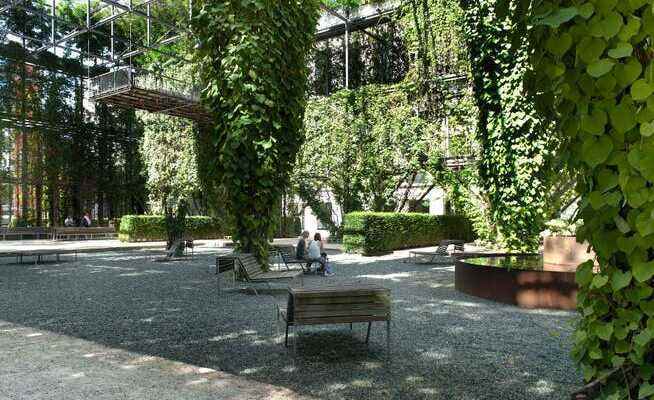Where there are no trees, climbing plants will provide shade in the future in the city of Zurich.
Based on the model of the MFO Park in Oerlikon, even more squares in Zurich are to be greened.
When Zurich turns into an oven on a hot summer’s day, only the die-hards stay in many squares in the city, because shady places are rare. There are hardly any trees on the Sechseläutenplatz, for example, the large area must remain free for the Circus Knie or the Zurich Film Festival.
Cities are considered “heat islands” because asphalt and concrete store heat, so Zurich is looking for ways to cool down the area in particularly hot spots. A fog machine has recently been installed on the Turbinenplatz in district 5, which is supposed to create a refreshing cloud at temperatures above 30 degrees. When City Councilor Simone Brander (SP) presented the installation called “Alto Zürrus” on Tuesday, there was not much of a cooling effect.
Now the city will look at how green roofs can provide shade in squares and courtyards. On Wednesday, Parliament submitted a corresponding proposal from Martina Zürcher and Sebastian Vogel (both FDP).
The MFO Park, which was created in 2002 on the site of the former machine factory in Oerlikon, serves as a model for such projects: here climbing plants grow up along a double-walled steel framework. The construction can be walked on and has a sun deck, with benches and loungers set up in the shade of the plant roof. Events also take place in the MFO Park, in August an open-air cinema.
The majority of the FDP’s idea was well received in Parliament. It’s definitely better than “Alto Zürrus”, said Beat Oberholzer (GLP) and thus immediately took a dig at the artificial cloud on the Turbinenplatz. In heat reduction projects, the focus must always be on planting trees with large crowns and building unsealed areas that can absorb rainwater well, Oberholzer explained. Nevertheless, one agrees with the postulate.
That was also the tenor of the council leftists, who all supported the initiative. More green spaces and trees are the most efficient way to cool the area, said Sofia Karakostas (SP). But there was often a lack of space for this. The SP advocated that so-called flower towers should also be used in cramped conditions because they save space, which the FDP supported.
Brigitte Fürer from the Greens was a little more critical. The MFO Park is a special construction and cannot simply be transferred to other areas. And: “If there is space for a steel frame, there is also space for a tree.” Actually, it is up to the municipal “sectoral planning heat reduction” to develop appropriate projects. Trust that this will happen. “Probably this approach is not needed, but it does no harm either, so we accept it.”
Only the SVP did not want anything to do with roofs made of plants, but the vote of their representative Jean-Marc Jung consisted almost exclusively of praise for such projects. Green covers are “natural air conditioning” in summer, they are a “cool thing” and would bind fine dust, said Jung and raved about the garden on the roof of the Galerie Lafayette department store in Paris. However, these plantings would have to be watered on hot days, which is not useful if water becomes scarce during a dry period. Therefore, the proposal is rejected.
On Wednesday, parliament passed without discussion a postulate by Flurin Capaul (FDP) and Marco Denoth (SP), which also deals with the topic of heat reduction: the two propose greening SBB tracks in urban areas. However, this requires the approval of the Federal Railways. In justifying the initiative, the postulants themselves admit that they may have reservations about planted tracks: There is a “certain reluctance” on the part of the SBB because greening could result in additional costs for the operation and maintenance of the tracks.
